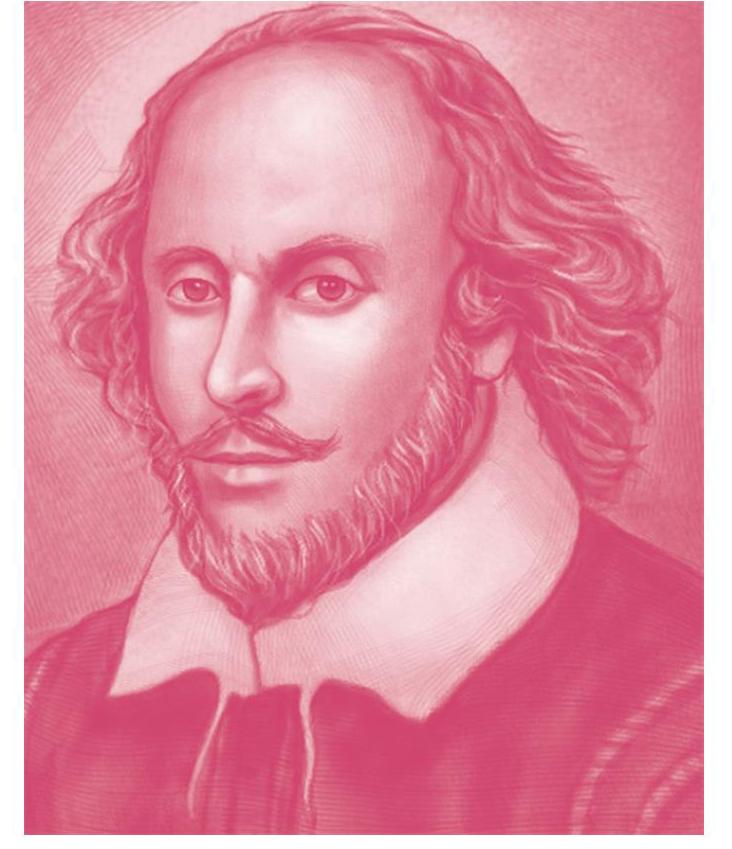Shakespeare’s Originality评《莎士比亚的原创性》
2020-12-23约翰·马兰
约翰·马兰


Shakespeare inhabited a literary culture in which imitation was applauded. This erudite study teases out1 his alchemical2 transformations of what he had read or seen.莎士比亞处在一个文学崇尚“因袭旧作”的时代。《莎士比亚的原创性》一书内容翔实,梳理了莎士比亚提炼融合所读所见进行戏剧创作的过程。
For a long time, the sedulous student who wants to see Shakespeare in the act of creation has been able to go to the extracts contained in the eight fat volumes of Geoffrey Bulloughs Narrative and Dramatic Sources of Shakespeare. Here you can find the stories that he pilfered3 and changed. You can see how he twisted two completely separate tales together to make The Merchant of Venice, for example, or decided to kill Lear and Cordelia at the end of King Lear when in his chronicle source4 both survived, or made Othello Desdemonas murderer5, when in Cinthios original Italian story, it is Iago who does the deed. The volumes give a dizzying sense of the playwrights narrative dexterity as you see him extracting and welding together the elements from others narratives.
Read John Kerrigan6s intense, condensed account of the playwrights creative borrowing and the dizziness only increases. Focusing on a handful of plays, Kerrigan, one of the worlds leading Shakespeare scholars, shows that Bullough has recorded only the more obvious half of it. Kerrigan takes us beyond Shakespeares primary sources into the deeper texture7 of his allusions and passages of imitation. His originality, by this account, was largely a gift for the alchemical transformation of what he had read, heard recited, or remembered from his days on a hard bench at Stratford grammar school.
Kerrigans introduction ruminates8 about the meanings of originality, a concept unknown to critics before the later 18th century. Shakespeare inhabited a literary culture in which imitation of earlier models was applauded. Rhetoric (the Renaissance version of creative writing) approved of “invention”, but specified that this meant the clever combination of inherited elements. Yet Shakespeare is also different from his contemporaries: he is not showing off his literary knowledge but adapting narrative patterns and fragments of dialogue lodged9 in his memory. Kerrigan quotes Emerson10 observing that “All minds quote”; yet most of Shakespeares quotations—or inventive misquotations—would not have been spotted by his first audiences.
A chapter devoted to Much Ado About Nothing reveals a play that is “pieced11 and patched and recycled” out of various Italian tales, its radical novelty a matter of the “piecemeal superflux” of reused materials. You will have to read slowly—and maybe Google—to understand the variety of materials (Ariosto12, Matteo Bandello13, Luigi Pasqualigo14) that go into this nearly tragic comedy. The reward is a vivid sense of how original it was to borrow.
Traditional assurances that Shakespeare knew next to15 nothing of Greek tragedy are upended in an analysis of King Lear and its relationship to Sophocless two Oedipus plays16. Shakespeare had access to these via widely available Greek/Latin parallel texts (we should take with a pinch of salt17 Ben Jonsons aspersions about his “small Latin and less Greek”). In particular, he found his way back to Greek tragedy via Senecas Latin versions of Greek originals. The scene on Dover Cliff, where the blind Gloucester thinks he has been led by Edgar, the son he does not recognise18, has its “original” in Senecas Phoenissae, where Antigone leads Oedipus in search of a convenient precipice19. “Layers of imitation resonate back to antiquity20.”
In his final chapter, Kerrigan tackles one of the few Shakespeare plays supposed to have no specific source, The Tempest. He finds here not only echoes of contemporary writing about the colonisation of Virginia and Bermuda21, but also the reuse of sentiments culled22 from Virgils celebration of the powers of agriculture, his Georgics. Where Shakespeare is supposed most natural he is in fact most literary23.
The book is unrepentantly erudite, but the erudition is as diverting as it can be daunting. There are digressions into mens hairstyles in Renaissance England (essential to some of the jokes in Much Ado), contemporary agricultural experiments (ditto24 The Tempest), or manners of walking on the stage (where actors strutted or “jetted”25 or jigged26 or “tripped”27 or—like Richard III—balefully limped). The chapter on Much Ado, a play in which a servant almost triggers a tragedy by dressing up as her mistress, traces its reliance on contemporary publications about fashionable dress. Elizabethan England still had sumptuary laws28, placing stern limits on the wearing of luxurious apparel. “Actors were an affront to these rules,” elaborate costuming being one of dramas essential resources. How exciting it was to see someone flagrantly29 dressed in the wrong clothes!
The four main chapters began as lectures30, and Kerrigan clearly expected his listeners to concentrate hard. He is confident he can use words such as “sticomythic” and “haruspication” without further explanation, that Euripides31 and Virgil32 are our familiars, and that the plot details of Shakespeares plays are hardwired in our heads. The text bristles with33 endnote numbers, taking the reader—if he or she wishes—to a compendium34 of Shakespearean lore at the back of the book. But the trust in our literary curiosity is intoxicating. Who wants Shakespeare to be made easy when he was so beautifully and originally complex? ■
很久以来,如有勤勉的学生有意考察莎士比亚的创作过程,可以去查阅杰弗里·布洛厚厚的八卷本《莎士比亚的叙事和戏剧来源》中的一些片段。该书记录了莎士比亚戏剧所挪用和改编的故事原型:比如,你会发现《威尼斯商人》是将两则毫无干系的故事糅在一起改编而成;《李尔王》中,李尔和科迪莉亚皆不得善终,而故事源起的《李尔王与三个女儿的真实编年史》中,两人结局圆满;莎翁笔下的奥赛罗杀死了苔丝狄蒙娜,而在钦齐奥原创的意大利故事中,伊阿古才是杀害苔丝狄蒙娜的凶手。这八卷本展现了莎士比亚娴熟的叙事技巧——“掇菁撷华,翻陈出新”,令人眼花缭乱。
约翰·克里根精辟扼要地介绍了莎翁这种“创新性借鉴”的叙事技法,读来更觉眼花缭乱。约翰·克里根是世界上最杰出的莎学家之一,他只集中探讨了少数几部莎剧,指出布洛仅仅记录了所有素材来源中较为明显的那一半。他带领我们突破故事原型局限,感受“引用”和“模仿”赋予莎剧的深层质感。莎士比亚在斯特拉特福文法学校苦学时曾读过、听过并记下了各种素材,按照克里根的说法,莎士比亚的原创性很大程度上得益于他对那些素材所做的炼金术般的提炼融合。
克里根在引言部分深入探讨了“原创性”的内涵。实际上,直到18世纪后期,评论家们才萌生“原创性”这一概念。莎士比亚则处在一个文学崇尚“因袭旧作”的时代。修辞学(文艺复兴时期的创意写作)认可“创作”,但明确指出这种“创作”不过是将既有素材巧妙地糅合在一起。即便如此,莎士比亚仍与同时期其他作家有所不同:他并非在卖弄自己的文学学识,而是重新演绎了记忆中的叙事模式和对话片段。正如克里根在书中引述爱默生所言:“人皆引用他人之言。”况且,莎士比亚引用的大多数内容(或创造性地有意曲解并引用)若不是经莎士比亚改写或传播,原本都将湮没无闻。
书中有一章专门讨论了《无事生非》,这是一部由多个意大利故事拼凑改写而成的戏剧作品,其根本创新之处在于对“大量零散”素材的高度回收利用。若想了解这部近乎悲剧性的喜剧作品背后复杂多样的故事原型(涉及阿里奥斯托、马泰奥·班戴洛和路易吉·帕斯夸利哥的作品),必须慢读细品,或许还得用搜索引擎查询相关资料。经过此般折腾,便能深刻感受到这部戏剧在借用素材上是多么独具创意。
传统观点确信莎士比亚对希腊悲剧知之甚少。书中分析了《李尔王》与索福克勒斯两部戏剧《俄狄浦斯王》《俄狄浦斯在科罗诺斯》的关系,所得结论颠覆了这一观点。得益于广为流传的希腊语或拉丁语对照文本,莎士比亚有机会接触这两部作品。尤其是通过阅读塞内卡根据希腊语原作改写的拉丁语版本剧作,莎士比亚得以“顺藤摸瓜”感受希腊悲剧经典。(本·琼森曾称莎士比亚“少谙拉丁,更鲜希腊”,此言失之偏颇,我们应对此持保留态度。)在《李尔王》中,双目失明的格洛斯特找人帶自己去多佛尔白崖自尽,殊不知护送自己的恰是儿子埃德加,这与塞内卡的剧作《腓尼基少女》中的一幕如出一辙:安提戈涅领着父亲俄狄浦斯寻找附近的绝壁。正如克里根所说:“层出叠见的仿写剧情与古老戏剧遥相呼应。”
克里根在书中最后一章讨论了《暴风雨》,据说这是莎士比亚为数不多未有特定取材来源的戏剧作品。然而,他发现《暴风雨》不仅在主题上呼应了莎翁同时代的相关文献——英国对弗吉尼亚和百慕大的殖民;在情感上,它也与维吉尔歌颂农业生产奥秘的作品《农事诗》有异曲同工之处。实际上,莎士比亚被认为最为朴实的作品恰恰最能够反映他的文学造诣。
本书涉及的资料极为广博,既可谓妙趣横生,同时也令人望而生畏。书中闲扯了一些题外话,如英国文艺复兴时期人们的发型(这对理解《无事生非》中的某些玩笑至关重要)、莎士比亚时期的农业实践(同样有助于读懂《暴风雨》),以及戏剧演员的舞台走姿(演员在舞台上是昂首阔步、疾步快走、活蹦乱跳、步伐轻盈,还是像跛足暴君查理三世那样步履蹒跚、一副不怀好意的模样)。在《无事生非》中,侍女因装扮成女主人险些酿成悲剧。以此为出发点,克里根在相关章节分析了莎士比亚戏剧在服饰描写上所受的同时期时尚书刊的影响。伊丽莎白时代的英国仍实行“禁奢法”,严格限制穿戴华服美饰。“戏剧演员们却公然蔑视这些规矩。”克里根的此番评论说明戏服是戏剧的基本要素之一。看着有人明目张胆地乱穿一气该多令人兴奋啊!
书中四个主要章节的内容最初以讲座的形式呈现,显然,克里根希望听众们做到聚精会神。他坚信自己可以直接使用“轮流对白的”和“肠占卜”这类生僻词汇而不必加以解释;他还相信读者熟知欧里庇得斯和维吉尔,且对莎剧的诸多剧情细节谙熟于心。本书包含大量尾注,如有兴趣,读者可以在结尾附录部分查阅莎士比亚戏剧的相关知识典故。不过,认为读者拥有对文学的好奇心,这让人沉迷其中。毕竟,莎士比亚戏剧创作之复杂精彩绝伦又独具匠心,谁愿意(为了方便理解而)去繁就简呢? □
(译者为“《英语世界》杯”翻译大赛获奖者)
1 tease out(将纠缠在一起的东西)整理;得出。 2 alchemical炼金术的;炼丹术的。此处用来形容莎士比亚提炼他人素材为自己所用。 3 pilfer一点儿一点儿地偷窃。
4在莎士比亚的悲剧《李尔王》之前,曾有过一部名不见经传的剧作《李尔王与三个女儿的真实编年史》(The True Chronicle History of King Leir, and His Three Daughters, Gonorill, Ragan, and Cordella),出版于1605年,作者不明。这部戏剧结局圆满,李尔在科迪莉亚的帮助下恢复了皇权。 5奥赛罗受小人伊阿古谗陷蛊惑,在新婚的床上,亲手掐死了忠贞而单纯的妻子苔丝狄蒙娜。当伊阿古的妻子揭穿这一谎言与骗局的时候,奥赛罗如梦初醒,拔剑自刎。 6英国当代著名的莎士比亚、英诗研究专家与文学批评家,现为英国剑桥大学圣约翰学院英语教授。 7 texture(艺术作品等的)神韵;质感。 8 ruminate寻味;反复思考。
9 lodge铭记;留存。 10拉尔夫·沃尔多·爱默生(1803—1882),美国散文作家、思想家、诗人。他是确立美国文化精神的代表人物。美国前总统林肯称他为“美国的孔子”“美国文明之父”。 11 piece拼合;拼装。 12 (1474—1533),意大利文艺复兴时期诗人,代表作是长篇传奇叙事诗《疯狂的罗兰》(Orlando Furioso)。 13 (1480—1562),意大利文艺复兴时期杰出的小说家。他从1505年到晚年总共写了短篇小说214篇,对意大利和欧洲文学产生了很大影响。 14 (1536—1576),威尼斯士兵兼作家,其戏剧作品《伊利·费代勒》(Il Fedele)经英国剧作家安东尼·曼迪(Anthony Munday)改编成《费代勒和福尔图尼奥》(Fidele and Fortunio)。
15 next to(用于否定词前)几乎;差不多。 16指《俄狄浦斯王》(Oedipus Rex,或Oedipus the King)和《俄狄浦斯在科罗诺斯》(Oedipus at Colonus)。 17 take something with a pinch of salt 对……半信半疑;对……有所怀疑。 18李尔王的大臣格洛斯特伯爵轻信庶子埃德蒙的谗言,将长子埃德加放逐他乡。后来他由于维护李尔王,被挖去双目,流落荒原。在野外流浪时他遇到沦为乞丐、装疯卖傻的长子埃德加,由他搀扶前行,却不知搀扶他的就是被自己驱逐的儿子。
19 precipice悬崖;峭壁。 20 antiquity古代;古时(尤指古埃及、古希腊、古罗马时期)。 21弗吉尼亚是英国在北美大陆上设立的第一个殖民地,也是其在海外建立的第一个殖民地,于1607年由弗吉尼亚公司首建,于1624年升格为英国皇家殖民地。1609年,海盗冒险家乔治·萨莫尔斯爵士(Sir George Somers)率领船队前往弗吉尼亚,目的是救济已在两年前殖民的詹姆斯敦(Jamestown)殖民地,船舰在百慕大海域遭遇风暴失事,生还者上岛避难滞留,从而创建了百慕大殖民地。莎士比亚的剧作《暴风雨》可能受威廉·斯特雷奇(William Strachey)对这次海难的记述影响。 22 cull挑選;采集。 23 literary有典型文学作品特征的;精通文学的。 24 ditto(尤用于序列中)同上,同前。 25 jet快速移动。 26 jig精力充沛地跳舞(或走动);(尤指)蹦跳。 27 trip轻快地走(或跑、跳舞)。
28伊丽莎白时代通过的禁奢令中,对王室成员、有骑士或以上头衔者、小农、打工者和仆从等各个阶层所能穿着的服饰颜色、布料类型、价格,都给出了明确的标准,如“王室可以穿黄色布料和紫色丝绸,平民则只能买每码2先令以下的布料”。sumptuary(法令等)取缔挥霍浪费的。 29 flagrantly明目张胆地。 30克里根于2016年担任“牛津威尔斯莎士比亚讲座系列(Oxford Wells Shakespeare Lectures)”主讲人。《莎士比亚的原创性》的四大章节即根据讲座内容改编而成。
31欧里庇得斯(公元前480—前406),古希腊著名悲剧大师,与埃斯库罗斯和索福克勒斯并称为希腊三大悲剧大师。 32维吉尔(公元前70—前19),奥古斯都时代的古罗马诗人,其主要作品包括《牧歌集》《农事诗》和《埃涅阿斯纪》。 33 bristle with充满,布满。 34 compendium(尤指书中某题材事实、图画及照片的)汇编。
